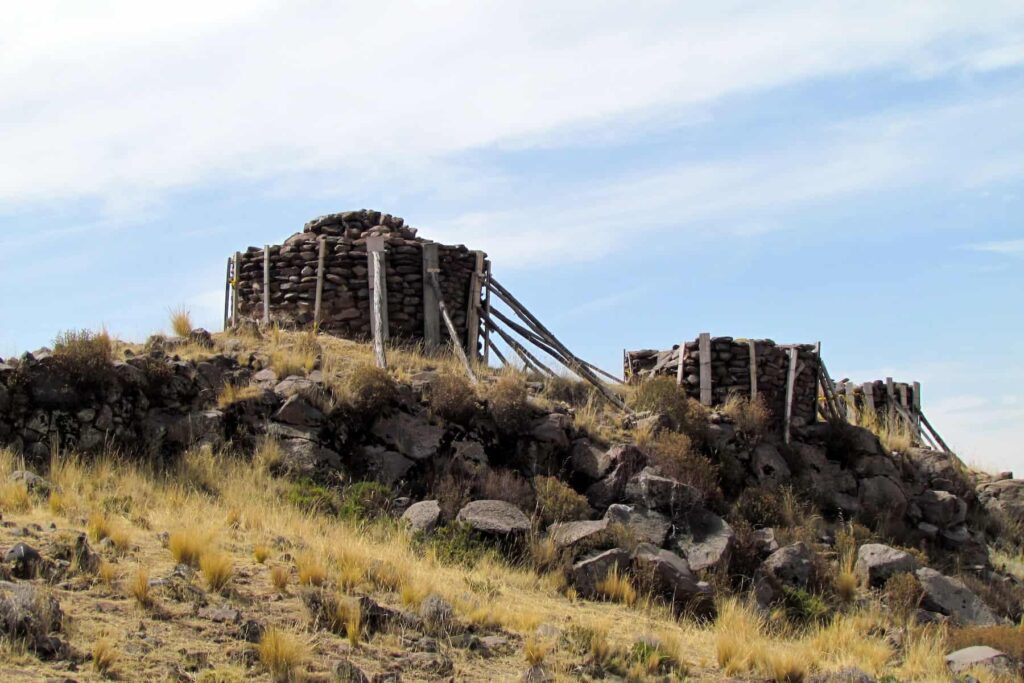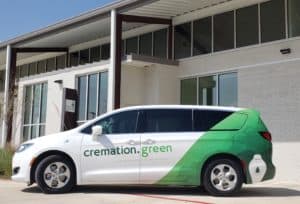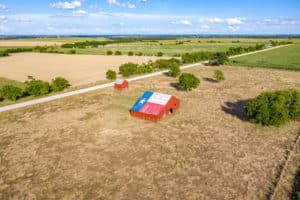When we think of burial usually the first thing that comes to mind is a sizable casket with glossy varnished wood, metal accents and pillowy satin lining. You probably also imagine images of a graveside service where the casket is lowered into the ground before being sealed in with cement and covered with flowers both real and imitation.
That’s what happens with a traditional burial. Green burial, also known as natural burial, is a completely different experience. The ornate casket is replaced by a plain wooden or wicker coffin that’s biodegradable. Sometimes there’s no casket at all and the deceased is laid to rest in only a cotton or linen shroud. The shallow 3-foot grave is then covered with earth without a concrete vault.
Green burial practices seem like a new, even radical, idea to some people. But when you consider how people have conducted burials in the past it’s actually practical and normal. Advocates of green burial will quickly point out that it’s essentially how things were done for thousands of years before the modern era of the funeral industry.
The Earliest Evidence of Burial
There’s no way of knowing when and where the first burial took place because the act of burying the dead began long before written language. However, archeologists and anthropologists have discovered numerous burial sites that were first dug tens of thousands of years ago.
The oldest undisputed gravesite that’s been discovered dates back at least 130,000 years. As you can imagine, there was little sign of what’s included in a “traditional” burial today. Although 130,000 years seems like a long time ago, the first burial may have actually taken place much sooner.
Sima Hominins: Earliest Natural Burial or Informal Disposal?
There have been two other archeological discoveries that may have been natural burials, although there is debate.
In the Atapuerca mountains of Spain during the 1980s, a cave chamber with the bodies of at least 28 individuals known as Sima Hominins was unearthed. It’s estimated that the bodies were roughly 430,000 years old. While this is undoubtedly a mass gravesite, many experts contest it is a burial site. Some believe the bodies were simply disposed of in the cave chamber after meeting a violent end and there was no real burial ritual to it. There’s also the possibility the bodies were washed there after a flood or they became trapped after venturing into the cave.
There’s also another instance of possible burial 236,000-335,000 years ago in the Rising Star Cave system. Homo Naledi skeletons, the first of their kind, were discovered in 2013. Three more sets of human remains were found in another part of the cave, but it is still undetermined whether or not it’s a burial site. Even if it isn’t a burial site, the Rising Star Cave discovery makes Homo Naledi the most documented hominin species to date.
Neanderthals Natural Burial: Inhumation Burial Begins
The form of burial that involves digging a hole in the earth, placing the deceased inside then covering everything with soil is known as inhumation. The earliest possible burials certainly didn’t fit inhumation standards from what we have discovered. While much is uncertain about possible earlier burials, scientists know a lot more about burial during the time of the Neanderthals, which isn’t contested.
Scientists know definitively that Neanderthals did bury people in the earth as far back as 50,000-130,000 years ago. They are credited with being the first to indisputably have mortuary practices. Artifacts show that Neanderthal deceased were buried in the ground. One of the most famous examples is the Neanderthal body discovered in a cave in La Chapelle-aux-Saints, France. A recent 13-year study confirmed the Neanderthal was not just buried there but obviously taken care of by others before dying.
There was an even more interesting find in Iraq’s Zagros Mountains in the 1950s. At least 10 Neanderthal bodies were unearthed in a cave. Two of the bodies suggested that not only were they buried but that flowers had been laid on top of one of the Neanderthals. A re-excavation of the site to examine the possibility of burial rituals led to the discovery of more bodies that further suggest ritualistic burial.
Twenty other Neanderthal gravesites have been found in Western Europe adding more evidence that Neanderthals buried their dead. Of course, not all Neanderthals were buried. Some remains have been found unburied, and it’s uncertain in some cases whether the Neanderthal was buried.
But in the known cases, Neanderthal rituals appear to be much like today’s natural burial practices. The bodies were laid directly in the ground, possibly grouped together in different graves that were dug at different times. Given the time period, if any objects or flowers were included they would be made of natural, biodegradable materials.
So in essence, the green burials of today are reflective of the earliest burials in human history. Many would argue they also have the same deep connection to the earth, humankind and spirituality as burials during the Neanderthal era.
Green Burial Becomes Common for Modern Man
Long before we recorded history, humans believed in an afterlife and were capable of complex thought. That much is clear from the act of burying the dead in a ritualistic way. Burials tell the story of human spirituality when there were no words for it.
Around 10,000 years ago when humans began to create settlements, burial had become a common practice. So much so, what would be considered the first cemeteries began to appear. It was the Greeks who first came up with the term. But unlike today, many early cemeteries were public places where markets and events were held.
Volumes of books have been written on the subject of ancient burial because there are so many unique variations to the practice. In most cases, the body was cared for and prepared by family members. They would clean the body and wrap it in a cloth shroud. The body would then be buried directly in the ground or put in a simple wooden coffin. It’s the same exact concept for today’s green burial.
One other thing is clear about burials during this period – these burials were done with a purpose greater than simply getting a dead body out of the elements. There’s evidence that burial in some early cultures was done to please the gods or the usher the person on to the next life or afterlife.
With this in mind, people began to be buried with tools, jewelry and other objects. The ancient Egyptians are famous for the grand burial tombs of pharaohs that sometimes contained a whole household of goods, including people. Egyptians also developed the first embalming methods in 4,000 BC. Six hundred years later mummification would become common for the upper class.
As time went on, burial began to be less green as gravesites no longer contained only biodegradable materials. Funeral rituals also became less natural.
The Rise of “Traditional” Burials
By the 19th Century, the sentiment surrounding burial and cemeteries began to change. Cemeteries were no longer seen as public places to gather for various purposes. They became strictly a resting place for the dead, which further laid the groundwork for “traditional” burials that were far from natural because preservation of the land wasn’t a concern.
The more elaborate burials of today are largely attributed to religious funeral practices that include viewings and memorial services. Religious beliefs and rituals are very closely tied to burial, at least that has been the case for the last few centuries.
One of the most unnatural elements of traditional burial, the use of embalming fluid, came about because of the desire to have funeral services days after death with the body present. Embalming as its known today began during the Civil War. A doctor named Thomas Holmes embalmed officers who were killed in battle to preserve the bodies for funeral services before burial.
In the years that followed, embalming became commonplace, giving people the ability to delay funeral services by days or weeks. Arsenic solutions were originally used before formaldehyde became available. It wasn’t known until years later how toxic these substances are and the environmental damage they can do.
Going Back to Green Burials
Even though 8 out of 10 people plan to have either a traditional burial or cremation, which is the most common end of life service today, the number of people who are considering green burial is growing. While only 5% of burials today are considered green, 54% of Americans are open to the idea. A National Funeral Director Association (NFDA) survey also found that there has been a 72% increase in demand for green burial.
In recent years, there has been a newfound concern over the negative effect of traditional burials on the environment and clear issues over land conservation. The movement went mainstream when the Green Burial Council was formed in 2005.
This shift in environmental focus paired with the decline of Christianity and religious motivations has made green burial an appealing end of life option for many people in the U.S. The NFDA notes that green funeral services are a significant trend in the funeral industry. So much so, funeral homes are adjusting their business models and the NFDA now offers a Green Funeral Practices Certification.
The rise in cremations is also playing a role in green burial. More people choose cremation today than traditional burial. However, cremated remains are often buried in a final resting place. For the people that choose cremation for environmental reasons, green burial is preferred. Most green cemeteries around the country now dedicate part of the burial grounds strictly for cremated remains.
RESOURCES:
When did we start burying our dead? Science Focus https://www.sciencefocus.com/science/when-did-we-start-burying-our-dead/#:~:text=We%20can’t%20be%20sure,along%20with%20tools%20and%20bones.
The Creepy and Fascinating History of How Humans Get Rid of Their Dead. November 2, 2018. Science Alert. https://www.sciencealert.com/keith-eggener-ted-talk-on-history-of-the-cemetary
The Sima Hominins: An Ancient Human Cold Case. September 9, 2019. Discover Magazine. https://www.discovermagazine.com/planet-earth/the-sima-hominins-an-ancient-human-cold-case
Humanity’s Strange New Cousin is Shockingly Young and Shaking Up Our Family Tree. May 9, 2017. The Washington Post. https://www.washingtonpost.com/news/speaking-of-science/wp/2017/05/09/humanitys-strange-new-cousin-is-shockingly-young-and-shaking-up-our-family-tree/
Neanderthal Burials Confirmed as Ancient Ritual. December 16, 2013. National Geographic. https://www.nationalgeographic.com/news/2013/12/131216-la-chapelle-neanderthal-burials-graves/#close
New remains discovered at site of famous Neanderthal ‘flower burial’. January 22, 2019. Science Magazine. https://www.sciencemag.org/news/2019/01/new-remains-discovered-site-famous-neanderthal-flower-burial
Consumers Moving Past Tradition For Funerals, Survey Says. October 15, 2019. National Funeral Directors Association. https://www.nfda.org/news/media-center/nfda-news-releases/id/4703/consumers-moving-past-tradition-for-funerals-survey-says
How It All Started. Green Burial Council. https://www.greenburialcouncil.org/history.html






